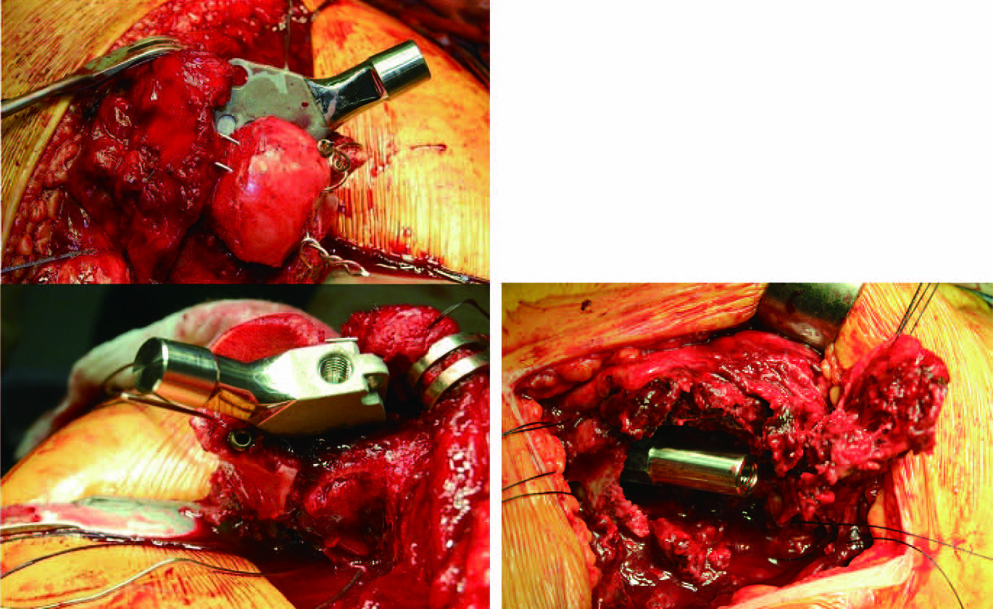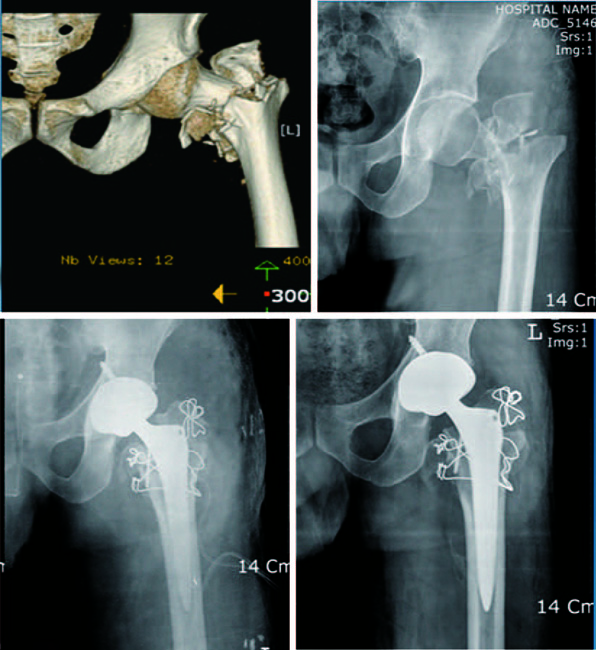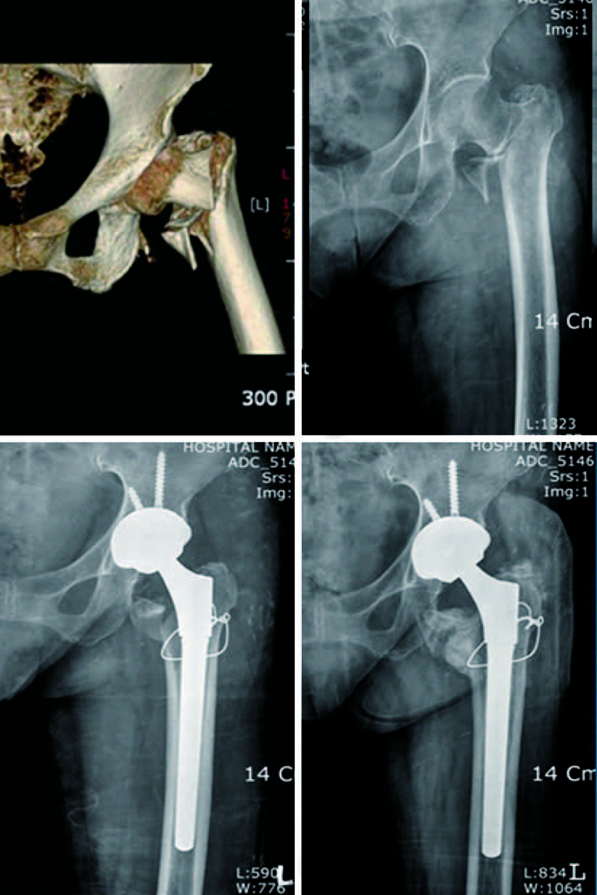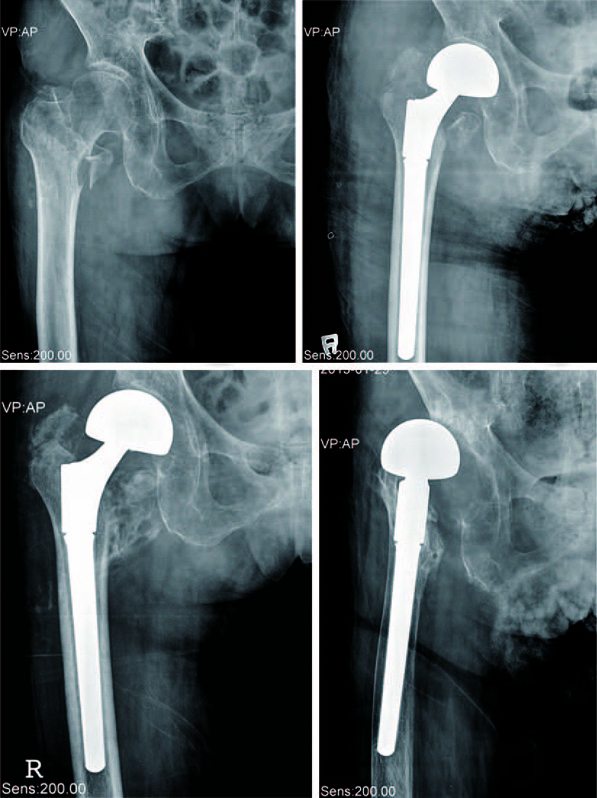Hip Pelvis.
2014 Sep;26(3):157-165. 10.5371/hp.2014.26.3.157.
Primary Cementless Hip Arthroplasty in Unstable Intertrochanteric Femur Fracture in Elderlys: Short-term Results
- Affiliations
-
- 1Department of Orthopaedic Surgery, Good Samsun Hospital, Busan, Korea. suhyun1123@naver.com
- KMID: 2054179
- DOI: http://doi.org/10.5371/hp.2014.26.3.157
Abstract
- PURPOSE
This study was aimed to explore and report the short term results of primary cementless hip arthroplasty in treatment of unstable intertrochanteric femur fracture in elderlys.
MATERIALS AND METHODS
Between March 2009 and Feburary 2012, 35 arthroplasty cases performed by single surgeon and followed up for more than one year were evaluated. They were 21 females and 14 males with mean age of 78 years (range, 71-92 years). Preoperative evaluation was performed by American Society of Anesthesia score. Retrospective evaluation was performed by operative time, transfusion amount, time to operation days, hospital stay and time to full weight bearing. Clinically, ambulatory ability was checked by Parker and Palmer (P&P) score and function of hip was appraised by Harris hip score (HSS). Radiologically, bone healing of fractured trochanteric fragment and presence of subsidence, stress shielding or osteolysis were checked.
RESULTS
Fracture type was 11 cases of A2.2, 18 cases of A2.3 and 6 cases of A3.3. Femoral stems used were 8 cases of rectangular tapered wedge type and 27 cases of fluted modular distal fixation type. P&P score improved from mean preinjury score of 7.1 to mean postoperative last follow-up score of 6.5. Median HHS at last follow-up was 75. Mean time to full weight bearing was 47 days (24-79 days). Postoperative complications were one case of linear periprosthetic femoral fracture and one case of postoperative dislocation.
CONCLUSION
Cementless hip replacement arthroplasty could be a good option for unstable intertrochanteric femoral fracture in elderlys.
MeSH Terms
Figure
Cited by 1 articles
-
The Fixation Method according to the Fracture Type of the Greater Trochanter in Unstable Intertrochanteric Fractures Undergoing Arthroplasty
Doohoon Sun, Byeong-Seop Park, Gun-Il Jang, Bongjoo Lee
Hip Pelvis. 2017;29(1):62-67. doi: 10.5371/hp.2017.29.1.62.
Reference
-
1. Kayali C, Agus H, Ozluk S, Sanli C. Treatment for unstable intertrochanteric fractures in elderly patients: internal fixation versus cone hemiarthroplasty. J Orthop Surg (Hong Kong). 2006; 14:240–244.
Article2. Cho SH, Lee SH, Cho HL, Ku JH, Choi JH, Lee AJ. Additional fixations for sliding hip screws in treating unstable pertrochanteric femoral fractures (AO type 31-A2): short-term clinical results. Clin Orthop Surg. 2011; 3:107–113.
Article3. Parker MJ, Palmer CR. A new mobility score for predicting mortality after hip fracture. J Bone Joint Surg Br. 1993; 75:797–798.
Article4. Hoffer MM, Feiwell E, Perry R, Perry J, Bonnett C. Functional ambulation in patients with myelomeningocele. J Bone Joint Surg Am. 1973; 55:137–148.
Article5. Koval JK, Zuckerman JD. Hip fractures: a practical guide to management. 1st ed. New York: Springer;2000. p. 174–176.6. Rockwood CA, Green DP, Heckman JD, Bucholz RW. Rockwood and Green's fractures in adults. 5th ed. Philadelphia: Lippincott Williams & Wilkins;2001. p. 1656–1657.7. Bonnevialle P, Saragaglia D, Ehlinger M, et al. French Hip and Knee Society (SFHG). Trauma Surgery Academy (GETRAUM). Trochanteric locking nail versus arthroplasty in unstable intertrochanteric fracture in patients aged over 75 years. Orthop Traumatol Surg Res. 2011; 97:6 Suppl. S95–S100.
Article8. Kim SY, Kim YG, Hwang JK. Cementless calcar-replacement hemiarthroplasty compared with intramedullary fixation of unstable intertrochanteric fractures. A prospective, randomized study. J Bone Joint Surg Am. 2005; 87:2186–2192.
Article9. Shen J, Wang DL, Chen GX, et al. Bipolar hemiarthroplasty compared with internal fixation for unstable intertrochanteric fractures in elderly patients. J Orthop Sci. 2012; 17:722–729.
Article10. Kim YC, Kim JW, Lim JY. Hip arthroplasty in intertrochanteric fractures: Is it acceptable treatment? J Korean Fract Soc. 2014; 27:105–112.
Article11. Kreder HJ. Principles and evidence: The optimal treatment of pertrochanteric hip fractures: Commentary on an article by Kjell Matre, MD, et al.: "TRIGEN INTERTAN intramedullary nail versus sliding hip screw. A prospective, randomized multicenter study on pain, function, and complications in 684 patients with an intertrochanteric or subtrochanteric fracture and one year of follow-up". J Bone Joint Surg Am. 2013; 95:e16(1-2).12. Exaltacion JJ, Incavo SJ, Mathews V, Parsley B, Noble P. Hip arthroplasty after intramedullary hip screw fixation: a perioperative evaluation. J Orthop Trauma. 2012; 26:141–147.13. Bercik MJ, Miller AG, Muffly M, Parvizi J, Orozco F, Ong A. Conversion total hip arthroplasty: a reason not to use cephalomedullary nails. J Arthroplasty. 2012; 27:8 Suppl. 117–121.14. Siwach R, Jain H, Singh R, Sangwan K. Role of hemiarthroplasty in intertrochanteric fractures in elderly osteoporotic patients: a case series. Eur J Orthop Surg Traumatol. 2012; 22:467–472.
Article15. Chu X, Liu F, Huang J, Chen L, Li J, Tong P. Good short-term outcome of arthroplasty with Wagner SL implants for unstable intertrochanteric osteoporotic fractures. J Arthroplasty. 2014; 29:605–608.
Article16. Grimsrud C, Monzon RJ, Richman J, Ries MD. Cemented hip arthroplasty with a novel cerclage cable technique for unstable intertrochanteric hip fractures. J Arthroplasty. 2005; 20:337–343.
Article17. Lee YK, Ha YC, Chang BK, Kim KC, Kim TY, Koo KH. Cementless bipolar hemiarthroplasty using a hydroxyapatite-coated long stem for osteoporotic unstable intertrochanteric fractures. J Arthroplasty. 2011; 26:626–632.
Article18. Parvizi J, Ereth MH, Lewallen DG. Thirty-day mortality following hip arthroplasty for acute fracture. J Bone Joint Surg Am. 2004; 86-A:1983–1988.
Article19. Park YS, Moon YW, Lim SJ. Revision total hip arthroplasty using a fluted and tapered modular distal fixation stem with and without extended trochanteric osteotomy. J Arthroplasty. 2007; 22:993–999.
Article20. Lee JM, Nam HT, Lee SH. Bipolar hemiarthroplasty with cementless femoral stem for unstable intertrochanteric fractures. J Korean Orthop Assoc. 2012; 47:79–85.
Article21. Zhang B, Chiu KY, Wang M. Hip arthroplasty for failed internal fixation of intertrochanteric fractures. J Arthroplasty. 2004; 19:329–333.
Article
- Full Text Links
- Actions
-
Cited
- CITED
-
- Close
- Share
- Similar articles
-
- Fracture of Fully-coated Femoral Stem after Primary Total Hip Arthroplasty for Nonunion of Intertrochanteric Fracture: A Case Report
- Bipolar Hemiarthroplasty with Cementless Femoral Stem for Unstable Intertrochanteric Fractures
- Fixation of Trochanteric Fragments in Cementless Bipolar Hemiarthroplasty of Unstable Intertrochanteric Fracture: Cerclage Wiring
- Fixation of Greater Trochanteric Fracture Using Double Strands and Double Loops with Figure of 8 Wiring in Non-cement Total Hip Arthroplasty for Unstable Intertrochanteric Fracture
- Cement Filling Technique to Prevent Greater Trochanter Displacement in Hip Arthroplasty for Femoral Intertrochanteric Fracture: A Technical Note






